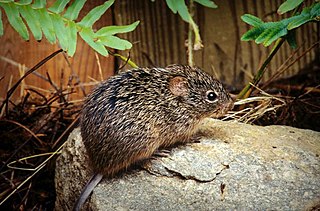Related Research Articles

This article seeks to serve as a field-guide, central repository, and listing for the flora and fauna of the US state of North Carolina and surrounding territories.

The hispid cotton rat is a rodent species long thought to occur in parts of South America, Central America, and southern North America. However, recent taxonomic revisions, based on mitochondrial DNA sequence data, have split this widely distributed species into three separate species. The distribution of S. hispidus ranges from Arizona in the west to Virginia to the east and from the from the Platte River in Nebraska in the north to, likely, the Rio Grande in the south, where it meets the northern edge of the distribution of S. toltecus. Adult size is total length 202–340 mm (7.9–13 in); tail 87–122 mm (3.4-4.8 in), frequently broken or stubbed; hind foot 29–35 mm (1-1.3 in); ear 16–20 mm (0.6-0.9 in); mass 50-250 g (1.7-9 oz). They have been used as laboratory animals.
Ctenophthalmus pseudagyrtes is a species of fleas in the family Hystrichopsyllidae. It is widespread in North America, east of the Rocky Mountains, and is found mainly on small mammals. In Missouri, it has been recorded on the Virginia opossum, northern short-tailed shrew, eastern mole, raccoon, eastern chipmunk, Florida woodrat, prairie vole, woodland vole, white-footed mouse, including nests, marsh rice rat, hispid cotton rat, house mouse, and brown rat. Hosts recorded in Tennessee include the Virginia opossum, northern short-tailed shrew, eastern mole, eastern chipmunk, southern red-backed vole, rock vole, woodland vole, white-footed mouse, golden mouse, hispid cotton rat, marsh rice rat, and house mouse.
Epitedia wenmanni is a species of flea in the family Hystrichopsyllidae. It is common throughout North America and associated mainly with Peromyscus (deermice), although many other hosts have been recorded. In Missouri, it has been found on the cat, white-footed mouse, including nests, marsh rice rat, and western harvest mouse. Hosts recorded in Tennessee include the northern short-tailed shrew, eastern chipmunk, southern red-backed vole, white-footed mouse, and golden mouse.
Polygenis gwyni is a flea that commonly infects the hispid cotton rat in the southern United States; it is also frequently found on other species ecologically associated with the cotton rat. Hosts recorded in South Carolina include the cotton rat as well as the Florida woodrat, cotton mouse, marsh rice rat, and brown rat.

Amblyomma maculatum is a species of tick in the genus Amblyomma. Immatures usually infest small mammals and birds that dwell on the ground; cotton rats may be particularly favored hosts. Some recorded hosts include:
Euschoengastia peromysci is a mite in the genus Euschoengastia of the family Trombiculidae. Recorded hosts include the cotton mouse and marsh rice rat in Georgia; the northern short-tailed shrew, northern red-backed vole, northern flying squirrel, rock vole, white-footed mouse, and deermouse in Tennessee; and northern red-backed vole, southern bog lemming, masked shrew, and eastern red squirrel in North Carolina, among others.
Listrophorus is a genus of parasitic mites in the family Listrophoridae. North American species with their hosts include: